Tricholoma virgatum (Fr.) P. Kumm. - Ashen Knight
Phylum: Basidiomycota - Class: Agaricomycetes - Order: Agaricales - Family: Tricholomataceae
Distribution - Taxonomic History - Etymology - Identification - Culinary Notes - Reference Sources
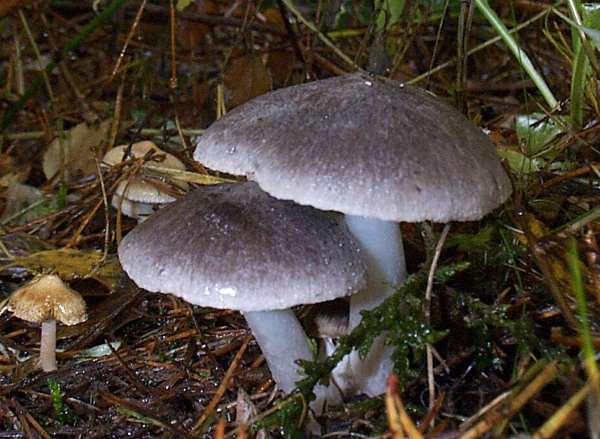
One of the more common of the many greyish Tricholoma species, the Ashen Knight is an easy-to-miss mushroom. It is mycorrhizal with broadleaf trees and with conifers on acid soil, where it usually occurs singly or in small groups.
Greyish Tricholoma mushrooms are many and not very varied. One feature that helps to distinguish this mushroom from some of its lookalikes is the colour of the gills: they are very light grey (almost white) at first, darkening gradually as the fruitbody matures.
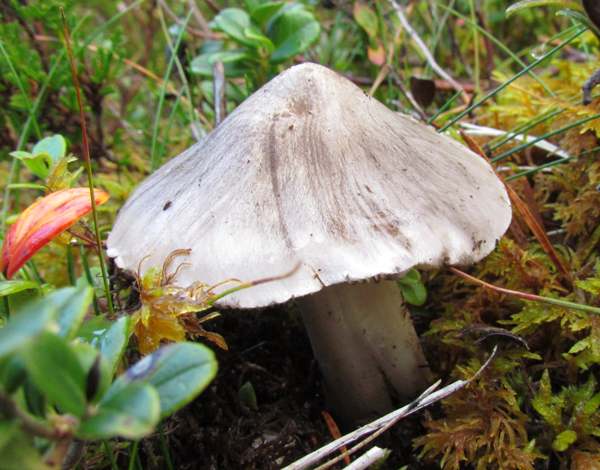
Distribution
An infrequent but far from rare find in Britain and in Ireland, where its distribution is patchy, Tricholoma virgatum is also fairly common throughout northern and central mainland Europe; it is also found in parts of North America.
Taxonomic history
This mushroom was first described scientifically in 1818 by the great Swedish mycologist Elias Magnus Fries, who named it Agaricus virgatus. (Most of the gilled mushrooms were included initially in the genus Agaricus, which has since been slimmed down considerably as many other new general have been created to house most of its former residents.)
German mycologist Paul Kummer transferred this and several other 'knights' to the genus Tricholoma in 1871.
Synonynms of Tricholoma virgatum include Agaricus virgatus Fr., Agaricus fumosus subsp. virgatus (Fr.) Pers., and Gyrophila virgata (Fr.) Quél.
Etymology
Tricholoma was established as a genus by the great Swedish mycologist Elias Magnus Fries. The generic name comes from Greek words meaning 'hairy fringe', and it must be one of the least appropriate mycological genus names, because very few species within this genus have hairy or even shaggily scaly cap margins that would justify the descriptive term. The specific epithet virgatum is Latin and means streaked or striped - a reference to the radial streaks on the cap.
Identification guide
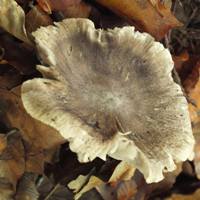 |
CapGrey or grey-brown, often with a hint of violet, and with darker radial fibrils or very fine scales; sharply conical then bell-shaped, sometimes flattening but retaining a sharp umbo (a conical pip) at the centre; margin slightly incurved; dry and silky; 4 to 9cm across. |
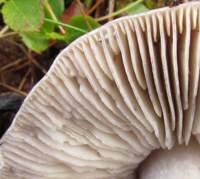 |
GillsVery pale grey, darkening with a pinkish tinge with age; crowded; sinuate or emarginate with a finely toothed edge (visible with an eye glass). StemWhite or pale grey; smooth, cylindrical or slightly clavate; 4 to 10cm long, 1 to 1.8cm diameter; no ring. |
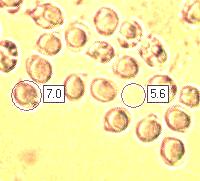 |
SporesBroadly ellipsoidal, smooth, 6-7.5 x 5-6.5µm, with a pronounced hilar appendage; inamyloid. Spore printWhite. |
Odour/taste |
Odour rather unpleasant, some say of radish; taste hot and peppery. |
Habitat & Ecological role |
Ectomycorrhizal with broadleaf trees and with conifers, usually on acidic soil. |
Season |
Summer and autumn in Britain and Ireland. |
Similar species |
Tricholoma terreum occurs under deciduous trees on alkaline soil; it is almost odourless. |
Culinary Notes
Tricholoma virgatum is not recommended as an edible mushroom and, because it is known to cause stomach upsets in some people. In any case, caution is required when gathering any greyish Tricholoma species because the few that are edible can so easily be confused with other slightly poisonous grey- or grey-brown capped species in the same genus.
Reference Sources
Fascinated by Fungi, 2nd Edition, Pat O'Reilly 2016, reprinted by Coch-y-bonddu Books in 2022.
Kibby, G (2013) The Genus Tricholoma in Britain, published by Geoffrey Kibby
BMS List of English Names for Fungi
Dictionary of the Fungi; Paul M. Kirk, Paul F. Cannon, David W. Minter and J. A. Stalpers; CABI, 2008
Taxonomic history and synonym information on these pages is drawn from many sources but in particular from the British Mycological Society's GB Checklist of Fungi.
Fascinated by Fungi. Back by popular demand, Pat O'Reilly's best-selling 450-page hardback book is available now. The latest second edition was republished with a sparkling new cover design in September 2022 by Coch-y-Bonddu Books. Full details and copies are available from the publisher's online bookshop...

